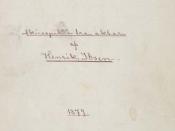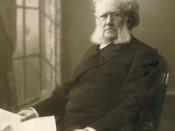Sylvia PlathÃÂs, The Bell Jar, and Henrik IbsenÃÂs, A DollÃÂs House, portray two women who try to live their lives within their respective time periods of the 1950ÃÂs and the 1870ÃÂs. Esther Greenwood and Nora Helmer both use their bodies and their sexuality to their advantage. Esther is depicted as an independent woman, yet breaks down as she reaches the age of 20. Nora is a very dependent woman, yet discovers herself and her own independence. In the end, both women seem to have both a bleak yet better future.
The typical women of the 1950s and the 1870s did not use their sexual appeal for anything. Those women were often looked down upon. Esther, however, used her sexuality as a form of rebellion. Esther largely represents a woman very ahead of her time. She refuses to be a typical 50ÃÂs woman who settles down, loses all ambition, and becomes a ÃÂslaveÃÂ to her husband.
Esther says, ÃÂI never thought for one minute that Buddy Willard would have an affair with anyoneÃÂ ÃÂWell, yes, I have,ÃÂ Buddy said finallyÃÂÃÂ I almost fell overÃÂ (Plath 69-70). She feels betrayed and scorned by Buddy, so she plays with her virginity to take revenge on Buddy Willard. Esther also toys with her virginity in order to contest the stereotype of women saving themselves for marriage. When she finally loses her virginity, she does not feel a spectacular change, yet she gets her revenge on Buddy and the world.
Nora has different motives, yet uses her body and sexuality to get her way nonetheless. Nora knows she is attractive and she knows that she has great pull over Torvald. When he asks her what she wants for Christmas, she flirts with him by playing with his coat buttons and eventually gets him to give her the money she wanted. She embraces her sexual appeal and uses it to her advantage. Nora says, ÃÂ(looks at him for a moment). For shame! (Hits him lightly on the ear with the stockings.) ThatÃÂs to punish you. (Folds them up again.)ÃÂ Not a single thing more, for being so naughtyÃÂ (Ibsen46). In order to get Dr. Rank to speak to Torvald on KrogstadÃÂs behalf, she flirts with Dr. Rank. She is fully aware what her sexual allure can get her.
Esther, contrary to the stereotype, is an extremely independent woman. She refuses to marry, due to the fear of her loss of ambition and her refusal to conform. Esther does not rely on anyone, and feels that she would be weak if she does. Esther does not even rely on her own mother when she admits, ÃÂ She said she was sure the doctors thought she had done something wrong because they asked her a lot of questions about my toilet training, and I had been perfectly trained at a very early age and giver her no trouble whatsoeverÃÂ I hate herÃÂ (Plath 202-203). Even with this independence, she falls into a regression and essentially loses her self. This raises the question, is that because she wasnÃÂt dependent on anyone? One would think so, but Esther eventually finds herself once again.
Nora, throughout the play, represents a typical 1870s woman who is extremely dependent on her husba and has a family. She, of course, has her differentiating qualities, but she is a general 1870s woman. Torvald is the source of her everything. Her clothes, jewelry, and food all derive from the money that Torvald makes. She is incapable of working and supporting herself because that is what she had grown up believing. Torvald says, ÃÂNora! The same little featherhead! Suppose, now that I borrowed fifty pounds today, and you spent it all in the Christmas week, and then on New YearÃÂs Eve a slate fell on my head and killed me, and--ÃÂ (Ibsen 6). This summarizes the entire social mentality of the 1870s. The quintessential ÃÂhusbandÃÂ treats the ÃÂwifeÃÂ as a doll and is fully aware that the wife is nothing without him. ÃÂThe husbandÃÂ, of course, would not even shutter to think that the ÃÂwifeÃÂ would ever defy or leave him. Consequently, Torvald is flabbergasted when Nora discovers her true self and walks out on Torvald.
Esther, an independent rebel, crumbles under the pressures of conformity. Nora, a typical housewife, finds herself and her independence. On the other hand, Esther ends up slowly finding herself, yet realizes the bell jar can always come back down on her. Nora also finds herself, yet one must think about how a single woman in the 1870s can provide for herself. A bleak yet bright future dimly shines on both Esther and Nora.
BibliographyThe Bell Jar by Sylvia PlathA Doll's House by Henrik Ibsen





